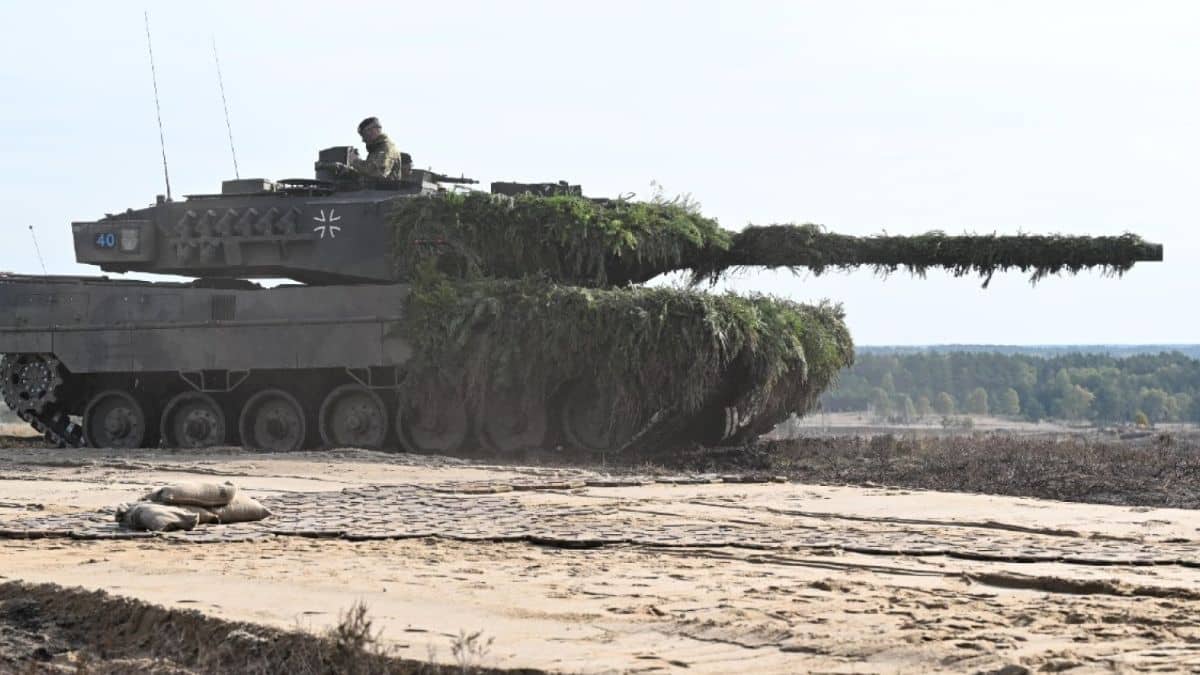 Image credits - Newsweek
Image credits - Newsweek
German main battle tanks of the third generation, known as Leopard 2, were developed in the 1970s by Krauss-Maffei and went into service in 1979. The Leopard 2, which was a major improvement over the Leopard 1 combat tank, was quickly assigned as the main battle tank of the West German army.
As a result of its outstanding design and capabilities, 13 other European countries have also adopted it, ensuring its continuous use in the German armed forces. Outside of Europe, the military fleets of Canada, Chile, Indonesia, and Singapore have utilised different versions of the Leopard 2. The Leopard 2 armoured vehicle is significant because it can be produced locally and developed domestically. Some of these nations have even gone so far as to licence the design, demonstrating the vehicle’s continued worldwide importance.
Specifications:
With their respective unique features, the Leopard 2A6 and 2A7V are powerful main combat tanks. The Leopard 2A6, with a mass of 62.3 tonnes and a length of 9.97 metres (gun forward), is operated by a crew of four. Strong protection is provided by its armour, which is made of third-generation composite materials with a ceramic component, tungsten, and high-hardness steel. Equipped with the potent Rheinmetall Rh-120 L/44 or Rh-120 L/55 120 mm main gun, it additionally has a secondary armament consisting of 2 × 7.62 mm FN MAG or 2 × 7.62 mm MG3A1.
This liquid-cooled V12 twin-turbo diesel engine, which produces 1100 kW at 2600 rpm and 17.8 kW/t of power, powers the tank. It is part of the MTU MB 873 Ka-501 series. With a maximum speed of 70 km/h and a fuel capacity of 1,200 litres, the Leopard 2A6 can travel 340 km on roads and 220 km over the country, with an average range of 280 km. Conversely, with a weight of 66.5 tonnes, the Leopard 2A7V is a little heavier and has a 16.6 kW/t power/weight ratio. It uses the same MTU engine as the 2A6 but has a different gearbox setup. It also has the same options for main and secondary armament. With a similar operating range of 340 km on roads, 220 km cross-country, and an average of 280 km, the 2A7V maintains a top speed of 70 km/h and a fuel capacity of 1,200 litres. The Renk HSWL 354 gearbox and torsion bar suspension of both tanks ensure dependability and versatility in a range of conditions.
Variants:
There have been numerous versions of the Leopard 2 main combat tank, each with unique enhancements. Better armour protection and component dependability were introduced with the Leopard 2A1. Although the Leopard 2A3 had a parking brake and better communications equipment, the 2A2 had better sights. With its improved turret armour, updated digital fire control system, and first-ever combat deployment in the 2016 Turkish intervention in Syria, the Leopard 2A4, manufactured between 1985 and 1992, emerged as the most popular variant. The Leopard 2A4 proved to be dependable and successful even in an older age, as demonstrated by a comparison test conducted in Poland.
Having 225 German Army tanks updated by 1998, the 1990-introduced Leopard 2A5 represented a significant development and was dubbed the greatest main battle tank in the world at the time. Equipped with upgraded armour and an elongated 120 mm/L55 gun, the Leopard 2A6 provides increased accuracy and range and is in use by multiple countries. With its increased armour, long-range surveillance cameras, and modern command and control electronics, the Leopard 2A7 elevated the platform even higher and became one of the world’s greatest main battle tanks.
More protection against explosives and anti-tank threats is a feature of the Leopard 2 PSO, which is designed for use in urban combat and peacekeeping missions. The most recent version, the Leopard 2A8, is equipped with a 120 mm/L55 cannon, the Trophy active defence system, and a potent 1,600 horsepower engine. Specialised vehicles like the PzH-2000 self-propelled howitzer, the Buffel armoured recovery vehicle, the Kodiak engineering vehicle, and the PBS 2 armoured bridge layer are part of the Leopard 2 family, in addition to the primary battle tank variants. The varied Leopard 2 lineup is further enhanced by a crew training vehicle, which highlights the platform’s adaptability and ongoing significance in contemporary armoured combat.
Operations:
In numerous overseas campaigns, the Leopard 2 tank has seen a great deal of use. German Leopard 2A5 tanks were sent to Kosovo in June 1999 as part of the Kosovo Force (KFOR) to take part in force displays, patrol, and guard checkpoints. Later, Leopard 2A4s took their place. The Dutch Leopard 2 tanks were deployed at multiple bases in Bosnia-Herzegovina as part of the IFOR/SFOR deployment. The Canadian Leopard C2s that were sent to Afghanistan in the early 2000s were replaced in 2007 with Leopard 2A6s that were borrowed. In 2007, Danish Leopard 2A5 DKs conducted operations in southern Afghanistan, and in 2008, Leopard 2 tanks participated in the Red Dagger operation in Afghanistan.
In December 2016, Turkey sent Leopard 2A4 tanks to Syria as part of Operation Euphrates Shield. Despite the deployment, Turkey faced difficulties, including ISIS losses. Some Ukrainian Leopard 2 tanks are said to have been destroyed or damaged in combat with Russian forces during the Russia-Ukrainian War in 2023. From the rough terrain of Afghanistan and Bosnia to the densely populated city of Syria and the conflict zone in Ukraine, the Leopard 2 proved adaptable in a variety of situations.
